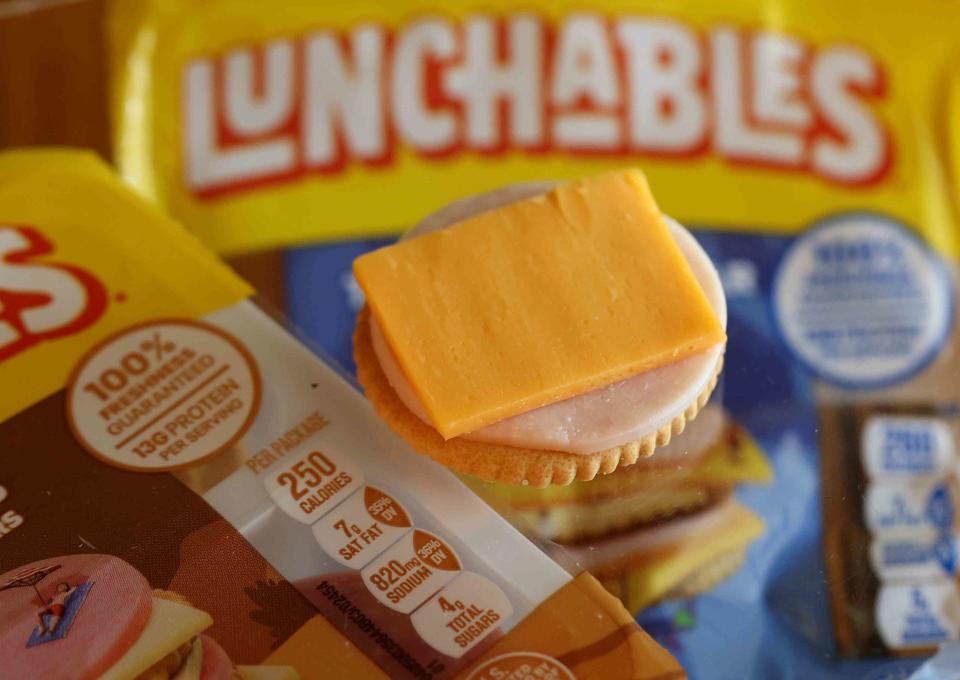Consumer Reports Warns Parents Lunchables May 'Not Be A Healthy Option For Kids'
Experts weigh in on what this means for this go-to quick meal for parents and kids.

Justin Sullivan / Getty Images
Fact checked by Sarah Scott
Lunchables have been a popular lunch choice since the 1980s, offering busy parents a convenient meal option for kids. However, Consumer Reports, a trusted nonprofit watchdog group, is now urging the Department of Agriculture (USDA) to remove Lunchables and similar lunch packs from the National School Lunch Program (NSLP).
Established in 1946, the federally assisted meal program provides free or low-cost lunches to nearly 30 million children nationwide in over 95,000 public, nonprofit private, or residential childcare institutions. Kraft Heinz, in partnership with the NSLP, introduced two new Lunchables last year, separate from those sold in stores, claiming on its website that the products offer “improved nutrition” compliant with “NSLP health standards.”
Despite these claims, Consumer Reports’ latest findings indicate Lunchables may “not be a healthy option for kids.” The company recently compared the nutritional profiles of the two Lunchable kits served in schools: "Turkey & Cheddar Cracker Stackers" and “Extra Cheesy Pizza.” Consumer Reports found higher levels of sodium than those sold in stores.
Additionally, the group tested these and 10 other kits found in stores and found “relatively high levels” of lead and cadmium.
“The scientists on our testing team were especially concerned because of the previous work they had done on preservatives and sodium levels in deli meat and so they incorporated this into their project list,” Brian Ronholm, Director of Food Policy for Consumer Reports, tells Parents. “The sodium findings weren't surprising, of course, but the findings on heavy metals and plasticizers were.”
What Did The Testing Find in Lunchables?
Consumer Reports' testing looked at sodium levels as well as phthalates, lead, and chromium. Here's what they found and what the experts are saying about each.
Sodium
The two school kits were not tested for heavy metals and chemicals, but Consumer Reports instead reviewed the nutrition information and ingredient lists and found extremely high levels of sodium.
The sodium levels in the lunch kits distributed in the NSLP program reportedly ranged from 460 to 740 milligrams (mg) per serving, which, according to Consumer Reports is nearly a quarter to half of a child’s daily recommended limit for sodium. The sodium values were based on the U.S. Dietary Guidelines for 4 to 8-year-olds, which is no more than 1,500 mg per day. The daily recommendation for 9 to 13-year-olds is no more than 1,800 mg.
The American Heart Association says eating too much sodium can lead to higher blood pressure in children and teens, with those consuming high-sodium foods being 40% more likely to develop hypertension. In a recent study from the American Heart Association, an estimated 2-5% of children have hypertension.
Phthalates
Consumer Reports previously tested store-bought Lunchables as well as similar kits from Armour LunchMakers, Good & Gather, Greenfield Natural Meat Co., and Oscar Mayer. They found lead, cadmium, or both in all.
The nonprofit also found “at least one type of phthalate,” in all but one of the kits it studied. The Lunchables Extra Cheesy Pizza was the only kit that did not test positive for phthalates.
Phthalates are chemicals used to make plastics more durable and can easily dissolve certain materials. It’s been nicknamed “the everywhere chemical” because it is found everywhere in household items, personal care products, and even food. Any food product packaged in containers made from these plastics has been exposed to the chemical.
Described by the National Institute of Health as “endocrine interruptors detrimental to human health,” Phthalate consumption can lead to diabetes, thyroid cancer, and reproductive and endocrine issues, among others. However, the CDC has recommended further studies of phthalates because they consist of a huge class of chemicals they do not have enough information on.
“None of the products exceeded any regulatory limits, but many researchers think those limits are far too permissive, given the emerging research about phthalates harms,” said Eric Boring, PhD, a Consumer Reports chemist who led testing of the products.
Lead and cadmium
None of the kits Consumer Reports studied “exceeded legal or regulatory limits” of heavy metals. They used California’s standards for lead and cadmium, which are the most stringent in the country.
The standard for lead and cadmium measurement is called the maximum allowable dose level (MADL), which is 0.5 micrograms (mcg) for lead and 4.1 mcg for cadmium. The study found that five of the 12 tested lunch products would expose someone to 50% or more of California’s maximum allowable level, which is still within the guidelines.
“Exposure from lead-based paint hazards is the leading source of lead exposure, but we know children can be exposed to lead from a myriad of sources including dietary sources,” says Marissa Hauptman, MD, MPH, FAAP, and Co-Director of the Pediatric Environmental Health Center at Boston Children’s Hospital.
Lead and cadmium are metals that occur naturally in the earth’s crust. Activities, include mining, burning fossil fuels, and manufacturing, and gets into food after plants absorb it from the soil, air, and water. The metals have been found in rice and grains, shellfish, vegetables, and even some dark chocolate bars, as found in another Consumer Reports study.
While both contaminants are naturally found in the environment, the Food and Drug Administration (FDA) says frequent exposure and consumption could lead to developmental problems in children, as well as hypertension, kidney damage, and cancer. The CDC says no level of lead is considered “safe” for children.
However, the FDA also acknowledges that it would be impossible to remove lead entirely from our food supply, which is why Dr. Hauptman says there is a need for more proactive environmental regulations to minimize all sources of lead before children and pregnant individuals are exposed.
What Does Kraft Heinz Say About The Findings?
A spokesperson for Kraft Heinz says it adheres to all regulations and stands by the quality and integrity that goes into making Lunchables. The spokesperson says they even “feed them to our own children.”
To meet nutrition requirements set by the NSLP, Kraft Heinz added more whole grains to the crackers and more protein to the Lunchable kits distributed in schools, according to the Consumer Reports study.
Despite the MADL standard used in the Consumer Reports study, a Kraft Heinz spokesperson described the Consumer Reports findings as “misleading, causing undue concern over the safety of our products.”
“The National School Lunch Program-approved Lunchables adhere to all USDA standards,” the spokesperson tells Parents. “We increased the amount of meat in the products to increase protein levels and help fuel kids throughout the day. With more meat comes naturally elevated levels of sodium to ensure safe preservation of the product.”
“All our products tested well below the acceptable limits. The metals they focus on are naturally occurring, and thus low levels may be present in any food product. We do not add these elements to our products.”
But Consumer Reports is urging the company to do more.
“Yes, these products tested below the California allowable limit for lead, but it's very problematic when one small serving of a product takes up 70 percent of that allowable limit,” argues Ronholm. “That leaves very little margin for error, especially—to their point—it's naturally occurring and so it's likely present in other food products.”
“If someone were to consume this product—and this product only—it would be fine. However, there are other meals that get consumed in a day,” he continues. “The arguments that these are 'naturally occurring' and 'we don't add these elements' ring hollow when you consider that there are food companies that, upon discovering high lead readings, evaluate their supply chain and take steps to reduce levels.”

Michael S. Williamson / The Washington Post via Getty Images
What Are the Next Steps?
There is currently no recall regarding Lunchables, but Consumer Reports has created an online petition to the USDA, which has more than 17,000 signatures, asking to remove Lunchables from the National School Lunch Program.
In a statement to Parents, a USDA spokesperson says it “takes very seriously our responsibility to ensure school meals are of the highest nutritional quality,” but it does not allow or disallow individual food items in the lunch program because their requirements address the overall content of their meals.
“The Lunchables described in the article would need to be paired with fruit, vegetables, and milk,” the spokesperson says. “In addition, a school who wanted to serve a higher sodium product one day has to balance that with lower sodium items on others,” they explain.
Dietary Guidelines for 2025 are currently under review and could include stricter rules on ultra-processed foods and school lunches. The FDA also cautions that testing results that detect lead and other chemicals do not mean the food needs to be avoided altogether.
"Maintaining optimal health through well-balanced nutritious meals is strongly recommended. Whenever possible, limit exposure to potentially harmful chemicals and additives such as salt that may exceed USDA standards,” advises Robert Pedowitz, DO, and Medical Director of Family Practice of CentraState. “If able, also try to opt for more fresh fruits and vegetables to provide vital vitamins and nutrition,” he added.
If parents have concerns about their child’s potential lead exposure based on the Consumer Reports study or other sources, it is important they discuss these concerns with their pediatrician or another health care provider.
For more Parents news, make sure to sign up for our newsletter!
Read the original article on Parents.

